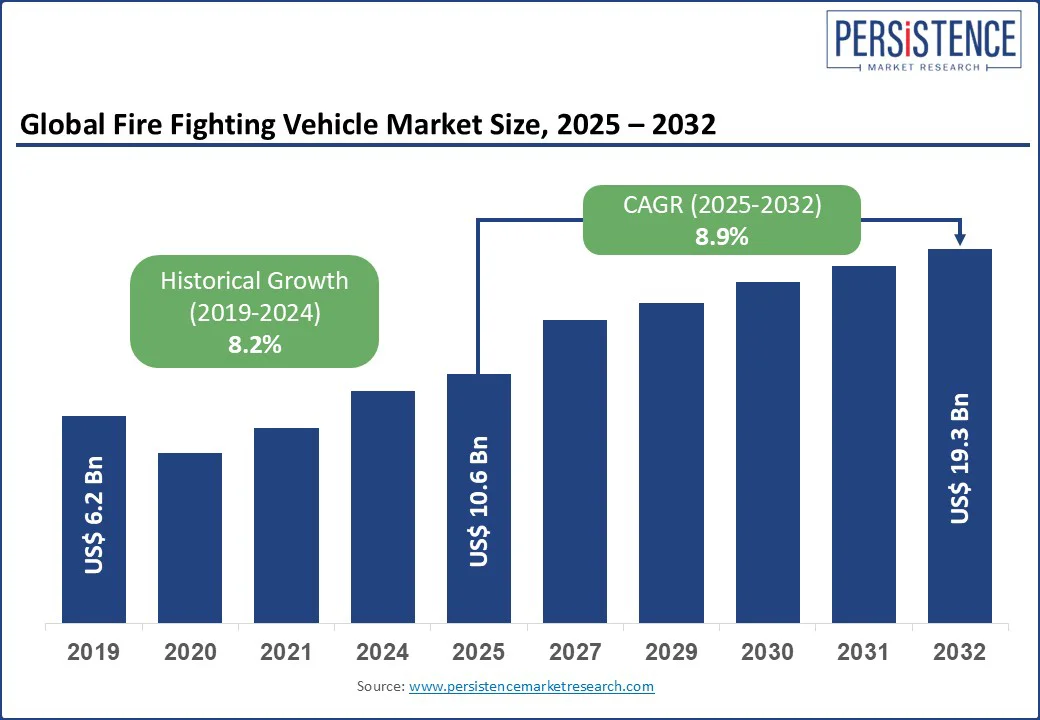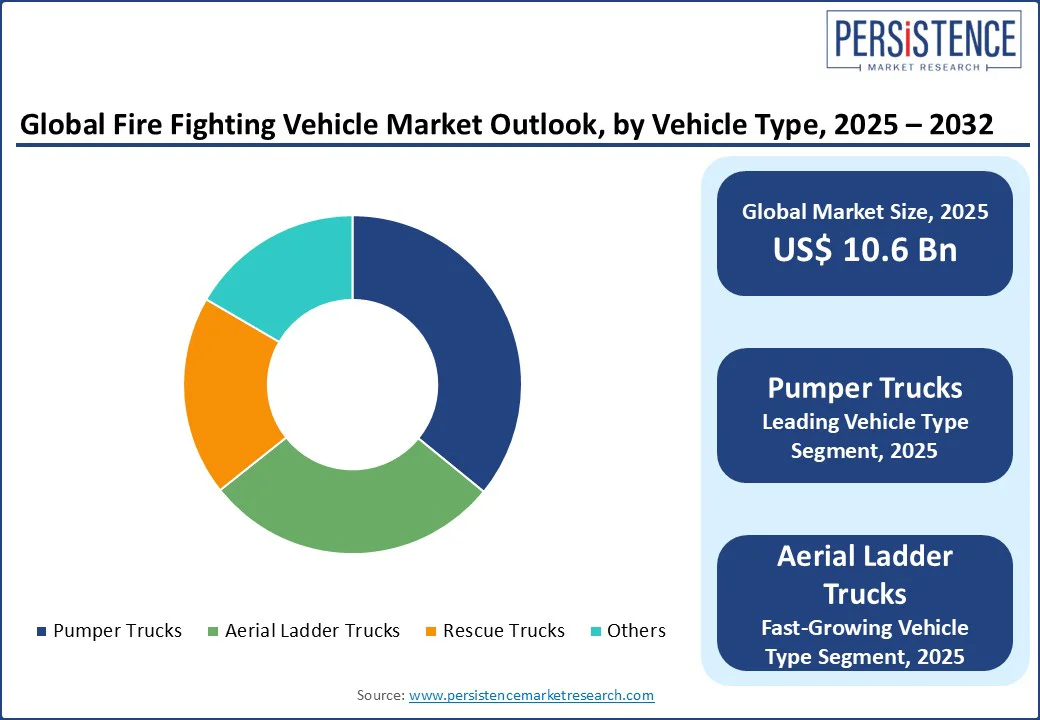ID: PMRREP35548| 197 Pages | 5 Aug 2025 | Format: PDF, Excel, PPT* | Automotive & Transportation

The fire fighting vehicle market size is likely to be valued at US$ 10.6 Bn in 2025 and is estimated to reach US$ 19.3 Bn in 2032, growing at a CAGR of 8.9% during the forecast period 2025-2032. Evolving risk, climate volatility, and strict urban safety regulations drives the need for fire fighting services. As the urban landscape grows and wildfire seasons intensify, both municipal authorities and private operators are boosting fleet modernization with specialized platforms for diverse fire scenarios. They are investing in novel electric engines to reduce urban emissions as well as multi-axle aerial units to enable high-rise access. This is attributed to the ongoing shift in demand toward intelligent and mission-specific vehicles that improve operational efficiency.

Key Industry Highlights
|
Global Market Attribute |
Key Insights |
|
Fire Fighting Vehicle Market Size (2025E) |
US$ 10.6 Bn |
|
Market Value Forecast (2032F) |
US$ 19.3 Bn |
|
Projected Growth (CAGR 2025 to 2032) |
8.9% |
|
Historical Market Growth (CAGR 2019 to 2024) |
8.2% |
Increasing frequency and intensity of wildfires across the globe are pushing the fire fighting vehicle market growth in regions facing recurrent heatwaves, prolonged droughts, and forest mismanagement. In 2023, Canada experienced its worst wildfire season on record, with over 18 Mn hectares burned, which was more than six times the annual average. This crisis prompted the country’s government to allocate additional federal funds for wildfire response. It included the procurement of new off-road-capable fire engines as well as rapid deployment units equipped with high-capacity water tanks and foam suppression systems.
In California, wildfire seasons are now nearly year-round. Hence, state fire agencies such as Cal Fire extended their fleet with Type 3 wildland engines and tactical water tenders designed for steep, rugged terrains. Demand is also shifting toward more versatile and agile units. For instance, in Australia’s New South Wales, the 2023 to 2024 bushfire season led to the acquisition of compact 4x4 Compressed Air Foam System (CAFS) trucks. These are becoming essential due to fires increasingly threatening peri-urban areas.
The shortage of skilled emergency-vehicle operators is emerging as a key constraint for fire fighting vehicle adoption, mainly as departments invest in complex next-generation platforms. Novel fire engines, including hybrid-electric models, require specialized training beyond conventional firefighting or Class B driving licenses. However, in the U.S. and Canada, several fire departments are struggling to attract and retain operators certified to handle these high-tech vehicles. Similar shortages are reported in the U.K. and parts of Germany, where agencies are offering incentives to retired drivers to return temporarily and conduct training.
High upfront costs of next-generation fire trucks are further slowing adoption. For example, the Pierce Volterra electric fire truck, now operating in departments such as Madison and Portland, costs over US$ 1.8 Mn, which is approximately 40% higher than its diesel counterpart. Various small-scale municipalities and rural fire departments cannot afford this investment without state or federal grants, which are limited and highly competitive. In addition, training costs and the operational complexity of new platforms are increasing the financial burden.
Increasing adoption of electric fire fighting vehicles is creating new opportunities in both product and infrastructure development. It is evident among OEMs, component manufacturers, and municipalities aiming for long-term sustainability. Electric fire trucks, once seen as experimental, are now entering operational fleets in cities such as Los Angeles, Berlin, and Toronto. Fleet electrification is also creating new revenue streams for EV infrastructure-based companies. Unlike standard EVs, electric fire trucks demand dedicated high capacity charging stations across firehouses, often requiring retrofits or new builds.
Electric fire trucks also come equipped with onboard diagnostics, energy management systems, and predictive maintenance tools. These are creating high demand for specialized software platforms and service contracts. These digital tools deliver improved visibility into fleet performance, enabling departments to monitor energy consumption, battery health, and route efficiency in real time. Hence, IT service providers and fleet management software companies are joining hands with fire truck OEMs to bundle digital offerings with vehicle sales.
Based on vehicle type, the market is divided into pumper trucks, aerial ladder trucks, rescue trucks, and others. Among these, pumper trucks are estimated to account for around 35.9% of the fire fighting vehicle market share in 2025 with their operational versatility, smooth deployment capabilities, and evolving modular designs that support a wide range of emergency scenarios. These trucks are essential in regions with limited hydrant access. In parts of Australia and rural Canada, where water sources are sparse, departments deploy pumpers with large onboard water capacities and high-lift pumps to draw from remote natural sources.
Aerial ladder trucks are gaining traction, backed by the rising demand for high-elevation firefighting and rescue capabilities in urban areas. In densely populated cities, where high-rise residential and commercial buildings dominate the skyline, conventional ground-level firefighting units often fall short. Hence, ladder-equipped vehicles capable of reaching upper floors quickly and safely are witnessing high demand.
In terms of application, the market is segregated into residential and commercial, enterprises and airports, military, wildland and forestry, and others. Out of these, residential and commercial is expected to hold nearly 55.7% of the share in 2025 due to the concentration of fire incidents and regulatory enforcement in this segment. According to the National Fire Protection Association (NFPA), over 74% of reported fire incidents in the U.S. in 2023 occurred in residential and non-industrial commercial structures. This high incident density requires dedicated firefighting fleets that are quick to deploy and ideal for urban response.
Wildland and forestry applications are witnessing a steady growth owing to the surge in large-scale wildfires propelled by climate change, land mismanagement, and prolonged drought conditions. According to the European Forest Fire Information System (EFFIS), 2023 witnessed more than 500,000 hectares of forest burn in the EU alone. This figure points to the increasing demand for specialized firefighting vehicles equipped to operate in rugged terrains where traditional engines are ineffective.

Growth in North America is spurred by increased modernization efforts, rising wildfire-related demands, and a surging shift toward electrification. The U.S. fire fighting vehicle market is predicted to dominate owing to large-scale replacement of aging fleets and the requirement for high-performance apparatus in both urban and rural settings. Fire departments in cities such as San Francisco have reported that over a third of their engines are too outdated to function reliably. It has prompted emergency replacement initiatives despite high acquisition costs, sometimes exceeding US$ 5 Mn per unit.
Electrification is a key trend in the market. The E-ONE Vector and Pierce Volterra, developed by REV Group and Oshkosh respectively, are the leading electric models being adopted across several cities. Specialty firefighting vehicles are in high demand across North America. Wildfire engines, airport crash tenders, and hazmat units are seeing increased procurement owing to surging climate and industrial threats. Municipalities and small towns are also making efforts to upgrade outdated units, thereby boosting demand.
In 2025, Europe is speculated to account for approximately 37.4% of share due to an ongoing technological and environmental shift. It is propelled by the continent’s regulatory push toward sustainability and modernization of emergency services. Several countries are investing in electric and hybrid fire trucks to reduce carbon emissions and noise pollution in urban areas. Germany’s Berlin Fire Department, for example, has deployed the Rosenbauer RT electric fire truck, and Vienna followed suit in 2024, integrating electric units into their urban fleets to meet EU Green Deal goals. These vehicles are equipped with lithium-ion batteries offering up to 100 km of all-electric range.
The market is also boosted by the aging infrastructure of various municipal fire departments, which are now replacing legacy fleets with modern, multi-functional vehicles. According to the European Fire Service Market Study 2024, nearly 38% of fire fighting vehicles in the EU are over 20 years old. It has prompted an urgent wave of procurement in France, Italy, and Spain. Procurement programs mainly emphasize modularity and digital integration, including onboard diagnostics and real-time location tracking.
The market in Asia Pacific is being pushed by rising fire safety regulations and increasing incidence of climate-induced disasters such as wildfires and industrial accidents. In 2024, for instance, China manufactured over 8,900 fire fighting vehicles, while India followed with around 3,500 units. This surge is supported by domestic procurement policies as well as local manufacturing by firms such as Zoomlion, Sinotruk, and Tata Motors. Surging demand is also fueled by strict safety norms in urban high-rises and industrial zones, primarily in cities developing under Smart Cities programs.
Japan and South Korea are moving toward technological developments. Japan’s fire trucks are known for their high reliability, earthquake-resilient design, and compact structure ideal for dense urban infrastructure. South Korea is integrating smart technologies such as IoT-based fleet management, thermal imaging systems, and AI-based risk detection into its fire fighting vehicles. This approach is helping companies to comply with the country's broad smart city agenda, with funding support from public safety grants and municipal programs.

The fire fighting vehicle market houses several renowned manufacturers specializing in heavy-duty emergency response equipment as well as niche players focusing on regional customization. Key companies dominate the market with extensive product lines developed for various terrains and emergency scenarios, including airport crash tenders and municipal pumpers. They compete on unique features such as integrated smart systems, high-performance foam, and modular vehicle platforms that enable fast configuration based on specific fire hazards. Europe-based players are investing heavily in electrification and hybrid technologies to comply with strict emission regulations and sustainability demands.
The fire fighting vehicle market is projected to reach US$ 10.6 Bn in 2025.
Government funding for disaster preparedness and industrial expansion in hazardous zones are the key market drivers.
The fire fighting vehicle market is poised to witness a CAGR of 8.9% from 2025 to 2032.
Emergence of custom-built wildfire vehicles and growth in airport infrastructure are the key market opportunities.
Rosenbauer International AG, Morita Holdings Corporation, and KARBA Automotive Machine Ind. are a few key market players.
|
Report Attribute |
Details |
|
Historical Data/Actuals |
2019 - 2024 |
|
Forecast Period |
2025 - 2032 |
|
Market Analysis |
Value: US$ Bn/Mn, Volume: As Applicable |
|
Geographical Coverage |
|
|
Segmental Coverage |
|
|
Competitive Analysis |
|
|
Report Highlights |
|
|
Customization and Pricing |
Available upon request |
By Vehicle Type
By Propulsion
By Application
By Region
Delivery Timelines
For more information on this report and its delivery timelines please get in touch with our sales team.
About Author